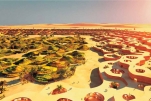Inhabiting the Desert: an Invisible Town Boucraa

The project created by Mikou Design Studio explores the traces left by mining activity in Boucraa, a town in the Sahara 100km southwest of Laâyoune, and proposes to transform and revitalise them in order to create conditions necessary for living in a salvational process of re-naturalising the ground which has been exploited.
The landscape is inhabited by a drapery of folds, faults and hollows, the results of crude ore extraction from the soil, and currently naturalised by the artificial hills and furrows of overturned earth which are the marks of mining activity. This project shapes the relief and topography so as to give substance to spaces which were previously impossible or unthinkable, spaces open to the sky, the sun and the moon, buried in the earth as a starry network, like a textured interweaving of masses and voids which will constitute the imaginary aspect of an invisible town. The architects distinguished between different landscape situations which are to be re-appropriated in order that they be inhabited and lived:
– Faultiness in the relief, in which we shall open pockets and folds at ground level, which will become at the same time focal points, open-air living spaces with housing organised around them.
– Artificial hills and other earthworks located further down, closed in by the landscape, which are to be naturalised and made green once more so as to constitute a prairie, a new oasis for the town. Certain dunes will be transformed into activity-spaces.
– Belvederes on the horizon which punctuate the skyline like the entry-gates of a city, and which are affirmative places from which the desert can be apprehended in its full vastness.
EXPERIENCE OF LIMITS
Boucraa, then, is an invisible town, a town buried under the meanderings of the ground at several levels, following the artificial topography resulting from mining works. Written into the archaeology of traces, and woven like a rocky lacework of folds and hollows oriented towards the landscape below the hills and furrows, it is only visible through its gates, conceived as watchtowers on the balcony of a broad landscape.
This invisible town, made up of successive, layered folds and faultiness, relies on the relief and geography in order to create a desert habitat, in continuity with cave-dwelling habitats. It rediscovers Edenic conditions, of the oasis seen through planted gardens lodged in the heart of fields of dunes, and evokes an “ecological well-being” won from the extreme conditions of nature in the desert.
Full content of this issue you can read here
The full version of the article can be read in our printed issue, also you can subscribe to the web-version of the magazine
 Materials provided by Mikou Design Studio
Materials provided by Mikou Design Studio


